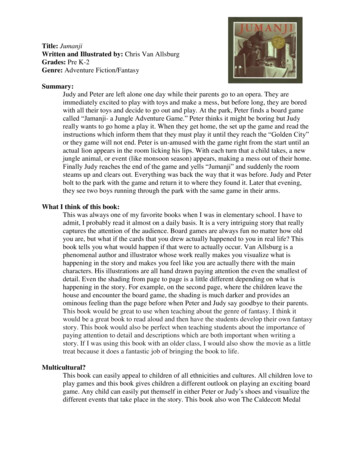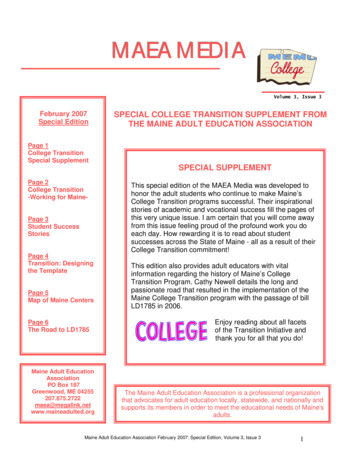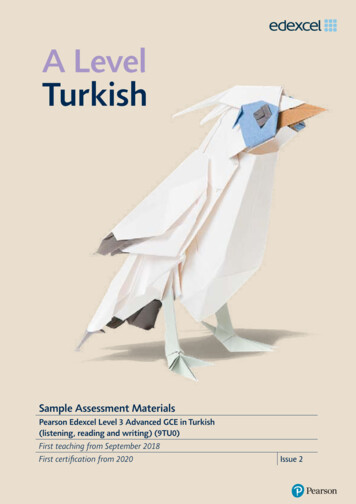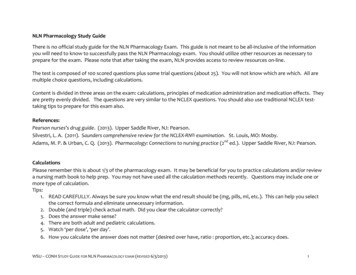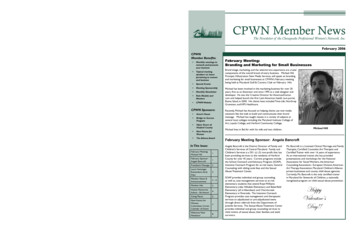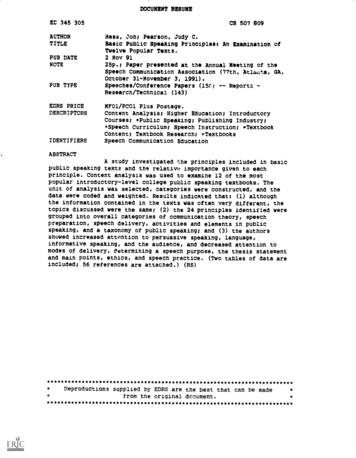
Transcription
DOCUMENT RESUMEEE 345 305AUTHORTITLEPUB DATENOTEPUB TYPEEDRS PRICEDESCRIPTORSIDENTIFIERSCS 507 809Hess, eon; Pearson, Judy C.Basic Public Speaking Principles: An Examination ofTwelve Popular Texts.2 Nov 9125p.: Paper presented at the Annual Meeting of theSpeech Communication Association (77th, Atlallta, GA,October 31-November 3, 1991).Speeches/Conference Papers (15C) -- Reports Research/Technical (143)MF01/PC01 Plus Postage.Content Analysis; Higher Education; IntroductoryCourses; *Public Speaking; Publishing Industry;*Speech Curriculum; Speech Instruction; *TextbookContent; Textbook Research; *TextbooksSpeech Communication EducationABSTRACTA study investigated the principles included in basicpublic speaking texts and the relativo importance given to eachprinciple. Content analysis was used to examine 12 of the mostpopular introductory-level college public speaking textbooks. Theunit of analysis was selected, categories were constructed, and thedata were coded and weighted. Results indicated that: (1) althoughthe information contained in the texts was often very different, thetopics discussed were the same; (2) the 24 principles identified weregrouped into overall categories of communication theory, speechpreparation, speech delivery, activities and elements in publicspeaking, and a taxonomy of public speaking; and (3) the authorsshuwed increased attmition to persuasive speaking, language,informative speaking, and the audience, and decreased attention tomodes of delivery, eatermining a speech purpose, the thesis statementand main points, ethics, and speech practice. (Two tables of data areincluded; 56 references are attached.) *************************Reproductions supplied by EDRS are the best that can be madefrom the original *****************************
PERMISSION TO REPRODUCE THISMATERIAL HAS BEER GRANTED BY9cr"U M. DEPARTMENT OP EDUCATIONOnce ol Educahorral Research and impio.ementEDuCATIONA( Rf SOURCES INFORMATIONCENTER IERICIilS1.45 documem ham Peen reproduced.0C eweI1 from the pelson of oroarutaIronorqpnarrn r11. M. changes have been made 10 ,mprOve,V0fOrhtelt0FIQuml.1yTO THE EDUCATIONAL RESOURCESINFORMATION CENTER (ERIC)"In,sClOCRomls oh vrevr co odour:Ars statedalplesPhl rrlirr arment d0 001 nfiCPSSA1140E111 posihon 01 polcyBasic Public Speaking Principles:An Examination of Twelve Popular TextsJon HessandJudy C. Pearson*cd)* Jon Hess is a doctoral student in Speech Communication at the University ofMinnesota, Minneapolis, Minnesota, and Judy C. Pearson is Professor of IncerpersonalCommunication at Ohio University, Athens, Ohio. This article is based on the masters'thesis of the first author which was directed by the second author. Paper presented atthe 1901 Speech Communication Association Convention; Atlanta, Georgia: November2, 1991.BEST COPY hAILABLE
The basic course is the mainstaj of the discipline (Seiler & McGukin, 1989). Formost students it is the first, and often only, contact with the discipline. As its impactcannot be discounted, scholars must continue to assess both its content and form.The importance of the basic course is reflected in the number of publishedstudies about basic public speaking. However, Schneider (1991) pointed out that fewstudies have focused on the textbooks themselves. Since the textbook is the foundationupon which the course is built, it is an important object of study.This study investigated the contents of basic public speaking texts. The primaryobjective was to compile a list of the principles included in basic public speaking texts.A secondary objective was to determine the relative importance given to each principle.This information should be valuable for instructors who teach public speaking, for.administrators who supervise the basic course, and for writers of textbciks andaccompanying materials. By articulating what educators can expect to find in basicspeech texts, this study should provide substantial pedagogical utility.Review of LiteratureThe History of the Basic CourseWhile concern with public speaking predates the birth of Christ and includesAristotles' The Rhetoric, the roots of the modern course can be traced to the mid-1800s(Macke, 1991). At that time, topics such as elocution, declamation and forensics werebeing studied. By the 1870s, though, elocution (considered an "imitative art") was losingpopularity. Reversal of this trend occurred in the 1880s when rhetoric was offered as acourse in English. Throughout the 19th century, public speaking was taught only in theEnglish department (Oliver, 1962).
2A key figure in the development of an independent speech communicationdiscipline was John Henry Frizzell. At the beginning of the 20th century, he was hiredas the first head of an independent speech department at Penn State University. Heestablished a basic course to teach students to "become plain, practical, organizedspeakere (Oliver, 1962, p. 249) and published one of the first modern speech textbooks(Frizzell, 1905). In 1909, he helped other prominent speech teachers organize theEastern Public Speaking Conference and the Speech Teachers of America. By 1912, thespeech department at Penn State offered five courses in public speaking. The modernpublic speaking course was born.Striking is how little change has taken place in the last 80 years. The earlyclasses were the foundation of today s basic course. Students made seven or eightextemporaneous speeches during the course (Trueblood, 1915). They learned boththeory and practice, with an emphasis on practice (Houghton, 1918). The focus includedaudience adaptation, speaking loudly enough, and several components fitting into therubric of organization (Kay, 1917). Students studied both verbal and nonverbal aspectsof delivery (Duffy, 1917), and the aims of the basic course included promoting betterspeaking habits, practicing speaking, overcoming stage fright, perfecting delivery,advancing thinking and improving organization (Hollister, 1917). The contemporarycourse largely reflects these concerns (Gibson, Hanna, & Huddleston, 1985; Hargis,1956).Beginning in the mid-1950s, and continuing to the present, regular surveys ofAmerican colleges and universities have monitored the nature of the basic course(Dedmond & Frandsen, 1964; Gibson, Gruner, Brooks, & Petrie, 1970; Gibson, Gruner,Hanna, Smythe, & Hayes, 1980; Gibson, Hanna, & Huddleston, 1985; Gibson, Kline, &4
3Gruner, 1974; Hargis, 1956; Jones, 1954; London, 1964). These surveys revealed fewchanges. Hargis (1956) found that the main foci of the course were speech composition,speech delivery, audience analysis, voice, and diction. Almost 30 years later, Gibson,Hanna, a.id Huddleston (1985) found similar results: outlining, delivery, and audienceanalysis were three of the six concepts allocated the most class time.Critique of today's basic courseThe basic course has never been blessed with a lack of criticism. It has beencriticized for not teaching what it needs to teach, teaching what is not ieeded, andteaching information that is not accurate (Pearson & Nelson, 1990; Trank, 1983).One long-lived criticism involves ethics, which is not given much emphasis.Williamson (1939) identified ethics as a necessary topic in the basic course andGreenburg (198(e) pointed out that the topic is still virtually ignored in the basic course.A more recent criticism is that the basic course does not teach work-related skills.Hanna (1978) found this to be a particular criticism of the business world. Johnson andSzczupakiewkz (1987) reported similar results; whereas alumni listed informative skills,listening, and handling questions and answers as the most important communicationskills at work; faculty endorsed outlining, topic selection, and entertaining speaking asthe most important areas of instruction.Some of these criticisms were addressed by Johnson and Szczupakiewicz (1987),who noted that the basic course is just a first course in speech communication, and mustbe viewed from that perspective. The fact that many students will not take anotherspeech course should not place the burden of trying to teach everything on the basiccourse. They noted:
4It is important to remember that "Introduction to Public Speaking" is generally abasic communication course restricted to one semester. Obviously, speechcommunication instructors cannot hope to cover every aspect of public speakingin one semester or term (p. 136).Future of the Basic CourseThe future of the basic course promises to be interesting. With a growingawareness of the unwavering nature of the basic course (e.g., Gray, 1989) comes theprospect of long-awaited change. Pearson and Nelson (1990) argued strongly thatmodifications in the basic course are long overdue.Although the basic course certainly has shortcomings, it has been extraordinarilysuccessful in weathering the test of time; this attests to its overall high quality. We mustexercise caution in modifications so that we address weaknesses and fortify the strengths.Indiscriminate changes will likely reduce quality. By beginning with careful study we canmaximize the effectiveness of changes.Textbooks in the Basic CourseThe first textbook was printed in America in 1650, and by the mid-twentiethcentury more than 2,500,000,000 textbooks were being printed worldwide. By then,textbooks had become the core of classes, and such a wide variety of texts wereavailable that the number was almost unmanageable. Clearly, textbooks have become adominant aspect of American education. Benthul (1978) wrote: 'The textbook is themost available, the most relied upon, and the most common material used in theclassrooms of America" (p. 5).
5A high quality textbook is an important component of an effective first course inspeech communication. Teague (1961) recognized the important role of the text whenhe wrote:It provides a common core around which to build a syllabus. Furthermore, ithelps conserve precious class time by making available an explarmion ofprinciples and of procedures that need not be discussed at length during the classperiod. (pp. 469-470)Although teachers are free to deviate from the material included in the texts, textbooksprovide a good overview of the basic concepts a student will be exposed to during thecourse.Like the course itself, public speaking textbooks have been amply criticized.Pelias (1989) noted that public speaking texts' treatment of communication apprehensionwas--while not incorrect--inadequate. Allen and Preiss (1990) found that amongpersuasion texts many contained incorrect information, and others were incomplete intheir coverage of material. Responding to their findings, Pearson and Nelson (1990)wrote "We should be ashamed that Aristotle is more consistent with what is known thanwe are ourselves" (p. 7).Whether or not textbooks accurately reflect the literature, they are indicative ofwhat is currently being taught in the basic course. Analysis of textbooks should provideinsights into what students can expect to learn in beginning speech.Principles of Public Speakin2The principles of public speaking have been the subject of considerable researchattention. Hayworth's early research (1939, 1940, 1941, 1942) merits attention. His goalwas to determine "whether or not certain phenomena related to public speaking can be7
a6measured" (1939, p. 378) and then to produce an effectiveness measure for publicspeaking. Hayworth also attempted to determine how certain phenomenon are relatedto speech effectiveness, and what techniques would be most successful in teaching thosephenomenon which were found to be fruitful. Through assessment of speeches,Hayworth produced relationships among personal attributes, teaching methods, and'various principles of public speaking.Surveys also monitor the important principles in public speaking. Althoughdetails vary, many phenomena are reported consistently in the surveys. For example,outlining, audience analysis, listening, voice and articulation, and support material wereall reported as important components of the basic course from the 1950s to the 1980s(Gibson et al., 1970; Gibson et al., 1985; Hargis, 1956).Although research has not provided a specific list of principles of public speaking,scholars are definitely in agreement about many concepts. The primary objective of thisstudy was to compile a comprehensive list of the basic principles which are currentlydiscussed in public speaking texts. Thus, the following research question wasinvestigated;RQ1; What are the principles of public speaking included in current basic publicspeaking textbooks?Not all principles of public speaking are of equal importance. Hayworth (1940)aptly demonstrated this by weighing and comparing the principles he studied. Hisresearch yielded some very specific relationships among selected concepts such as verbalfluency, eye contact, transitions, gestures, and facial contact.A measure of perceived differential importance of principles is class time devotedto each. For example, Hargis (1956) and Gibson et al. (1980) both reported that more8
7class time is devoted to speech delivery than to audience analysis. Differential spaceallotment in textbooks should also reveal a bias towards certain principles. Thus, asecond research question was investigated:RC)2:What is the relative importance given to each principle in public speakingtexts?MethodSampleSince this study examined the principles of public speaking as derived fromtextbooks, the population was the set containing all introductory-level college publicspeaking textbooks curreatly in use. This definition excludes those texts which arehybrids containing both public speaking and interpersone' communication, as well asother speech communication books such as persuasion texts, debate texts, and advancedpublic speaking textbooks.The purposive sample was intended to represent the most popular publicspeaking texts. The sample was determined on the basis of available surveys (Gibson,Hanna, & Huddleston, 1985; Gibson, Hanna, & Leichty, 1990; Pelias, 1989) andinformation from publishers. The twelve texts chosen for inclusion, and alphabeticallylisted, were Ayres and Miller's (1990) Effective public speaking (3rd ed.), Bradley's (1988)Fundamentals of speech communication: The credibility of ideas (5th ed.), DeVito's (1990)The elements of public speaking (4th ed.), Ehninger, Gronbeck, McKerrow, and Monroe's(1986) Principles of speech communication (10th ed.), Hanna and Gibson's (1989) Publicspeaking for personal success (2nd ed.), Hunt's (1987) Public speaking (2nd ed.), Lucas'(1989) The art of public speaking (3rd ed.), McCroskey's (1986) An introduction torhetorical communication (5th ed.), Nelson and Pearson's (1990) Confidence in public
8speaking (4th ed.), Osborn and Osborn's (1991) Public speaking (2nd ed.), Samovar andMills' (1989) Oral communication: Message and response (7th ed.), and Verderber's(1991) The challenge of effective speaking, (8th ed.).ProceduresContent analysis was used to examine these 12 texts. The research followed athree-step process (Budd et al., 1967; Stempel, 1989). First, the unit of analysis wasselected. Second, the categories were constructed. Finally, the data was coded andweighted. Although the word, sentence, or paragraph could be used as the unit ofanalysis, the page was found to be remarkably accurate since most basic public speakingtextbooks use the same size pages and type.The construction of the categories proved difficult since one of the objectives ofthe study was to determine the basic principles. Grounded theory (Glaser & Strauss,1967) was adopted to avoid imposing assumptions on the data. The principles thatemerged were resuired to be exhaustive, mutually exclusive, independent, and derivedfrom a single classification principle (Budd et al., 1967; Holsti, 1969). Constantcomparison helped to assure reliability of this approach.Once the categories were delineated, the items needed to be weighted to addressthe second research question. At the completion of the text analysis, items were rankordered according to units of analysis (by totaling the number of pages written abouteach) and according to frequency (which categories were mentioned by the greatestnumber of textbooks). These two systems of enumeration provided data concerning therelative importance of each item.
9ResultsThe analysis was conducted as described. The first text was coded into as manycategories as possible. Then each additional text was coded into those categories orwhen none existed, a new one was created. As the research progressed, underlyinguniformities began to emerge. These incidents were grouped into larger categories.After coding and reduction, outlines of the resulting principles were composed, quantitywas recorded, and reliability was determined.Reliability was calculated after the data was analyzed by recoding one of theearly textbooks in entirety. The results of the recoding were compared with the masterlist and the number correct was divided by the total. Mistakes involved failure torecognize an item, coding a7i item thzt was not relevant, and coding an item into thewrong category. Of 3,254 pieces of data, 3,157 were coded the same the second time,yielding a reliability of .97.Only face validity could be achieved for this study. To determine this, Lhe resultswere compared with the contents of the public speaking half of some popular hybrid(public speaking and interpersonal communication) texts. Almost all of the componentsappeared in these texts, and they compreherlvely covered the main points. The highreliability also bolster claims that the validity of this study is strong. The consistencywith which the data was coded (alpha .97) indicates that major theoretical deficienciesdid not appear.Research question one asked "What are the basic principles of public speaking?"This determined coding the bodies of the texts. Presumably, authors included all of theinformation which they considered essential in the texts, reserving for the appendbcmaterial they consider either optional or of lesser importance. Thus, appendices were11
10not coded. The results of coding appear on Table 1. These principles are thosementioned in over 83% of the texts. The 24 principles could be grouped into fiveoverall categories: communication theory, speech preparation, speech delivery, activitiesand elements in public speaking, and a taxonomy of public speaking.The second research question concerned the relative importance of the principles.This was analyzed by two factors: frequency of appearance and space allotted.Frequency was measured by calculating the number of texts in which an item appeared.The principles which authors hold to be most important should be in the most texts.These principles are presented in Table 1.Space allotted should give an indication of perceived importance. The number ofpages devoted to each principle was calculated. TM rc suit, listed in Table 1, is a meannumber of pages for each principle.Inwt Table 1 hereThe principles found in basic texts can be stratified into four levels. Persuasivespeaking, language, informative speaking, and the audience were the primary foci of thetextbooks. These topics were thoroughly discussed and relevant issues were explicated.The second level consisted of: getting information, presentational aids, listening,reasoning, organization, vocal and nonverbal aspects, speaking on special occasions, andsupport material. These topics, while allocated significantly less space than those inlevel one, were well-developed and treated as important building blocks in developinggood speech skills.12
\11The third level included outlining, the introduction, the speaker, selecting a topic,anxiety, components of communication, the conclusion, and modes of delivery.Discussion of these topics was comprehensive, but brief. Without exploring complexities,a clear overview was presented. The final level--determining purpose, thesis sentence,ethics, and practice--was composed of topics which were mentioned, but not reported indepth. Key ideas were highlighted, but little discussion accompanied the points.The principles were grouped into five supracategories, and these were checkedfor space allotted. The results are presented in Table 2.Insert Table 2 hereDiscussionTrank (1983) suggested that textbook authors are under significant pressure frompublishers to keep their books in conformity with competing texts. The results of thisstudy supported this allegation. Content analysis revealed that although the informationcontained in the texts was often very different, the topics discussed were the same. Thissuggests that even though scholars may not always be in agreement, pressure tostandardize may keep them writing about the same concepts.Maslow's hierarchy of needs provids a good example. Every text included it forvarying purposes, as if this is something which is expected in a basic public speaking textand each author must determine where to insert it. This study supports charges thatauthors are not free to write whatever they feel is important, but that they must maketheir text fit pre-established molds. Although this tends to stifle creativity and13
12innovation, it assures that students will learn comparable information regardless of thetext seh-qed.Woodward and Nagel (1987) reported that pressure exists for texts to have recentpublication dates; this is certainly true for basic public speaking texts. Research ft), thisstudy was conducted with the most recent edition of all the texts, yet by the time thecontent analysis was completed two of the texts had already come out in new editionsand had to be recoded. Sevitch (1990) noted that almost all the top-sellers come out innew editions every three or four years.Woodward tux! Nagel (1987) suggested that educators have begun thinking that ifa book is newer it must be better. The result is that "the industry seems to have beenforced into a hectic revision cycle in which improvement in instructional quality takes apoor second place to more superficial changes" (p. 1). Their study showed that the pushfor current editions can be hazardous to the quality of the product, and they concludedthat the danger of publishers sacrificing quality for "factors that have little educationalvalue" (p. 1) is very real. Since Woodward and Nagel's texts were from social studies,and the current study did not review multiple editions of texts, evidence has not beenprovided that basic public speaking texts deteriorate in quality with new editions.Given that public speaking texts are entrenched in the "hectic revision cycle," wemust be on guard that quality is not compromised for superficial changes. Writers orpublishers should be aware of the situation and use quality, not sales, as a guideline forchanges. Since no text is ever perfect, the demand for new editions should be used toencourage improvements in quality. If writers and publishers continuously seek fineimprovements, educators will be offered a better product.14
13Table 1 illustrates that the basic public speaking course synthesizes informationfrom a vast diversity of disciplines for use in a unified product. For example, productionof an effective actuation speech requires that a student do the following. First, she orhe must begin by seiecting a topic and purpose (English composition). Then the topicmust be thoroughly researched including library research (library science) andinterviewing experts (journalism and interpersonal communication) and the findings mustbe organized into a comprehensible presentation (English composition).Included in the case will probably Le reasoning (logic), and the whole argumentmust be prepared and presented ethically (ethics, philosophy, and even theology). If theaudience is to remember the message and feel compelled to respond to it, the speakerwill also need to apply principles of learning (education) and motivation (psychology).As presentational aids are vital to learning, applying principles of art and design willprove beneficial to communicating effectively via the visual channel. In many ways, thebasic public speaking course can be considered a capstone to the fundamental curricula:the course in which students must synthesize and apply much of their knowledge.Ethics is a topic that has received little attention in basic speech in both the pastand present (Greenburg, 1986; Pearson & Nelson, 1990; Williamson, 1939). AlthoughJensen (1985) noted signs that ethics might be growing in priority for speechcommunication texts, this trend does not appear to have developed yet. Ethics wasallocated an average of only 3.3 pages per text (consider for comparison that selecting atopic averaged twice that amount, and outlining received almost three times the space.One text did not even mention ethics.Furthermore, almost 58% of the texts studied included personal benefits oflearning public speaking in the first chapter, while only 41% mentioned social benefits.15
14A text which devoted six and a half pages to ethics (considerably more than average)later suggested using a one-sided approach to persuasive speaking when the audience ispoorly educated--a tactic designed to deceive audience members rather than to enlightenthem. The initial reaction to these points is that public speaking is being sold as a toolfor personal betterment and the speaker's responsibility to use it ethically is beingdownplayed.The validity of this conclusion is subject to question. Several explanations canaccount for the absence of ethics in the basic course. First, the obvious conclusionmight be correct: basic speech textbooks simply are devoid of ethics. Conversely,though, the possibility exists that ethics are taken for granted and writers see no point instating the obvious. Finally, since controversy rages as to what is ethical and what is not,authors may feel that it is best to simply mention the topic and note that speakersshould use their skill ethically, rather than becoming enmeshed in the debate overspecifics.Unfortunately, while this study effectively reveals the absence of discussion aboutethics, it does not provide answers as to why this is the case. By no means, though, canthis study support an allegation that ethics are unimportant in the basic speech course:the fact that 92 percent of the texts discussed the subject, one devoting an entire chapterto it, indicates that it is something of which writers and scholars are aware. Furtherresearch is needed to draw conclusions about why ethics are allotted such a smallpercentage of text space.This study reported the content of textbooks; researchers should now determinewhat instructors actually teach. If lectures are based primarily on the textbooks, theinformation here can be generalized as the basic principles taught in American colleges16
15questions need to beand universities on public speaking. If not, however, manywell-written textsinvestigated, like why teachers deviate from their text. With so manycould tint. texts tailored to theiron the market, it would be expected that instructorsparticular needs.The basic public speaking course may becontroversial, but the majority ofTwelve popularstudents in the course are receiving the same relative information.overall categories oftextbooks share 24 principles which can be grouped into the fiveactivities and elements incommunication theory, speech preparation, speech delivery,authors arepublic speaking, and a taxonomy of public speaking. Contemporary textbookthey are tomore likely to give a longer treatment to speech preparation thanspeaking,communication theory. Further, they show increased attention to persuasivedecreased attention to modes oflanguage, informative speaking, and the audience, andmain points, ethics, anddelivery, determining a speech purpose, the thesis statement andinformation to our knowledge of aspeech practice. This investigation adds furtherdiscipline.course that has become a mainstay in the speech communication
16ReferencesAllen, M., & Preiss, R. W. (1990). Using meta-analysis to evaluate curriculum: Anexamination of selected college textbooks. Communication Education, 32(2), 103116.Aristotle. (1932). The rhetoric of Aristotle (L Cooper, trans.). Englewood Cliffs, NJ:Prentice-Hall. (Original work published in antiquity)Ayres, J., & Miller, J. (1990). Effective public speaking (3rd ed.). Dubuque, IA:William C. Brown.Benthul, H. F. (1978). The textbook: Past and future. Curriculum Review, 11, 5-8.Bradley, B. E. (1988). Fundamentals of speech communication: The credibility of ideas(5th ed.). Dubuque, IA: William C. Brown.Budd, R. W., Thorp, R. K., & Donohew, L. (1967). Content analysis 21communications. New York: Macmillan.Dedmon, D. N., & Frandsen, K. D. (1964). The "required" first course in speech: Asurvey. The Speech Teacher, n(1), 32-37.De Vito, J. A. (1990). The elements of public speaking (4th ed.). New York: Harper &Rowe.Duffy, W. P. (1917). The foundation course in public speaking at the University ofTexas. Ouarlerly Journal of Speech Education, 2(2), 161-171.Ehninger, D., Gronbeck, B. E., McKerrow, R. E., & Monroe, A. (1986). Principles ofspeech cGmmunication (10th ed.). Glenview, IL: Scott Foresman.Frizzell, J. H. (1905). Notes on public speaking. Magnolia, MA. Privately publishedbooklet, 46 pp.
17Gibson, J. W., Gruner, C. R., Brooks, W. D., & Petrie, Jr., C. R. (1970). The firstcourse in speech: A survey of U. S. colleges and universities. The SpeechTeacher, 12(1), 13-20.Gibson, J. W., Gruner, C. R., Hanna, M. S., Smythe, M., & Hayes, M. T. (1980). Thebasic course in speech at U. S. colleges and universities. CommunicationEducation, 22(1), 1-9.Gibson, J. W., Hanna, M. S., & Huddleston, B. M. (1985). The basic course at U. S.colleges and universities: IV. Communication Education, 24(4), 281-291.Gibson, J. W., Hann
Eastern Public Speaking Conference and the Speech Teachers of America. By 1912, the. speech department at Penn State offered five courses in public speaking. The modern. public speaking course was born. Striking is how little change has taken place in the last 80 years. The e



